Sculpture Magazine / Digging Into the Future
January/February 2020
Article: by Joyce Beckenstein
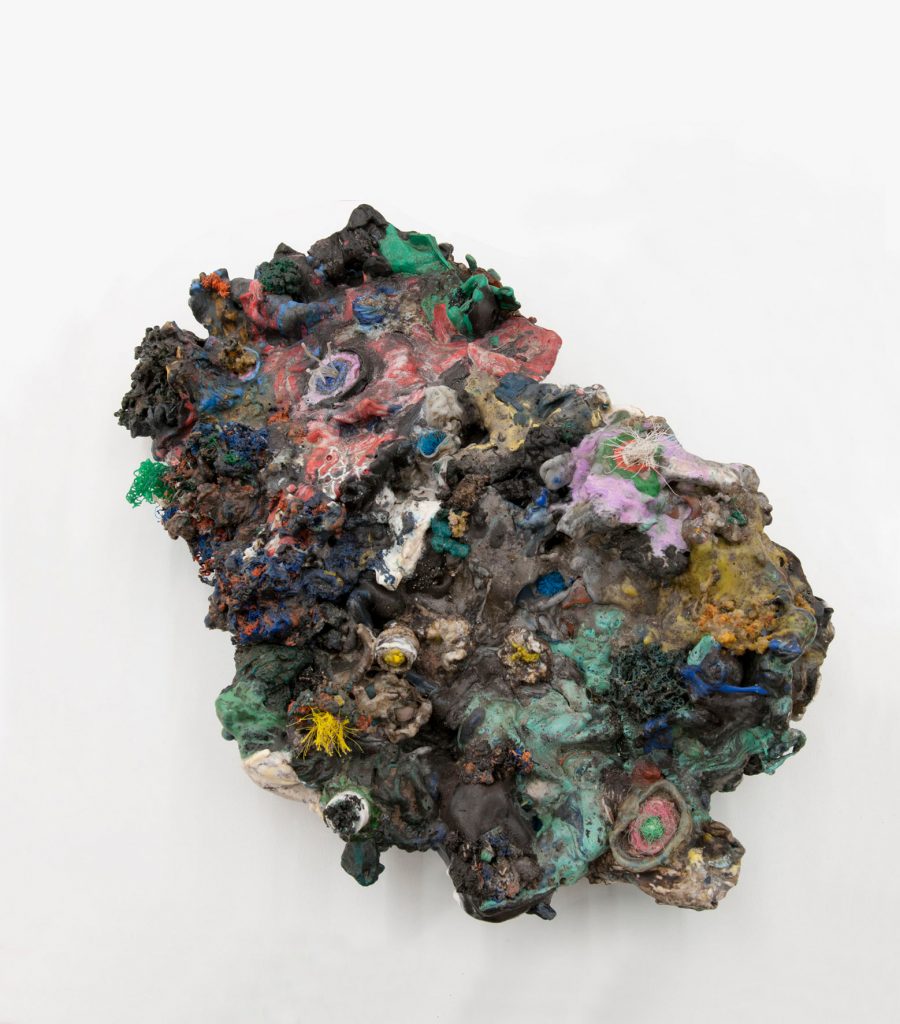
Plastic Reef (detail), 2008–2012. Melted plastic debris from the world’s oceans, 500 x 450 cm.
Born in Leuven, Belgium, Vanden Eynde was raised by “hippie” parents with an abiding respect for all things natural and human wrought. “Most of my clothes were handmade, or secondhand,” he told me. “I was the first in my family to have a driver’s license—the first ‘capitalist’ to own a car and a house. My mother was an artist; my dad worked in the library. He’s a walking encyclopedia. So, I got a cultural immersion at an early age. As a student, I disliked assignments and was one of the weirdos not working within the bounds of any one medium.” This background reverberates in his work, a seamless merger of intense scientific inquiry and quirky intuition that consistently disarms as it informs.
Restauration du Lac de Montbel (2003), a photograph documenting a performance without a live audience, finds the young faux-archaeologist sitting in a drought-dried lake in the south of France, filling its cracks with plaster. Within the parched landscape, he sees pieces of an ecological puzzle and hopes to learn about time past from the elegant tracery. But there are no obvious clues to the once luscious flow of cool water, the muddy sludge, or the grassy flora basking in warm sunlight. Though he can only imagine these things, Vanden Eynde projects the mortal need to know and to leave an imprint on time.
He calls his sci-art archaeology “Genetology: The Science of First Things,” a discipline he coined in 2003 to ponder the clues about human culture that might lie buried within the detritus of the Anthropocene age and how they might be analyzed. Contemporary scholars say that the Anthropocene, a recently defined geological era, began in the 19th century with the Industrial Revolution, when human interaction with the environment began to pollute the seas, decimate forests, and render extinct earthly creatures large and small. Vanden Eynde’s early Genetologic “research” pieces together the debris of manufactured objects that may one day be discovered buried within the earth. For Genetologic Research Nr. 2&4 (2003) and Genetologic Research N° 23 (2005), he dissected and reassembled a variety of wooden furniture parts, cobbling together an odd assortment of differently grained woods and finishes that at their ends form a complex pattern of mismatched “growth rings.” These (re)constructs—bizarre distant relations to trees as we know them—underscore the sad prediction of our forests becoming extinct while revealing the huge margin of error in the future genetologist’s thinking. Clearly, Vanden Eynde’s forensic avatar serves as a metaphor for how human knowledge is shaped by incomplete information, misinformation, and personal and cultural agendas.
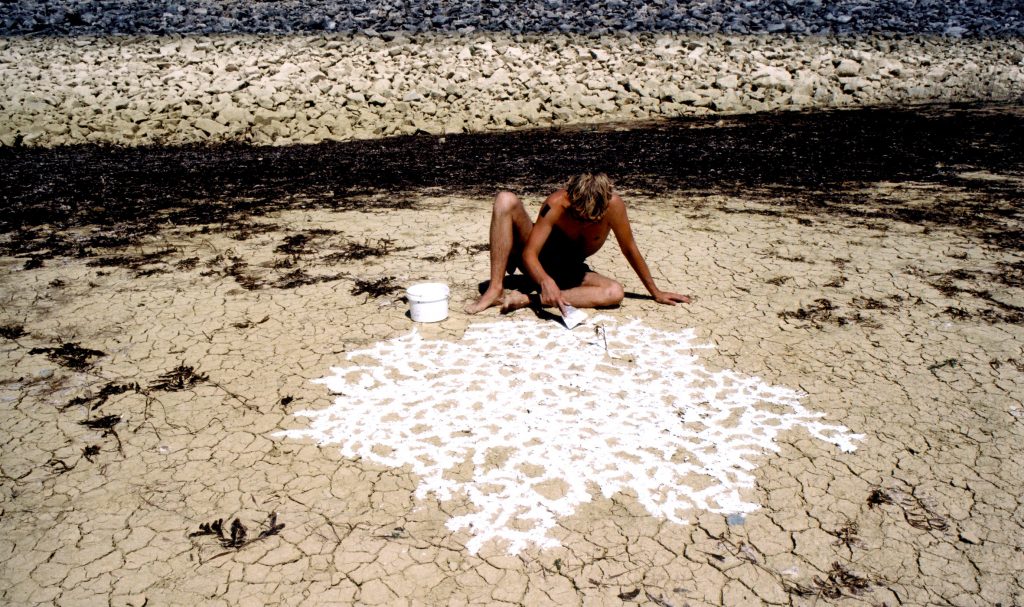
Restauration du Lac de Montbel, 2003. Photoprint, 70 x 50 cm. (Photo: Marjolijn Dijkman)
He similarly examines the vagaries of how rational beings develop their rationales, analyze the written word, and sort through the conundrums of distinguishing cultural contexts from wildly disparate sources. What, for example, would one make of an IKEA catalogue found alongside a Bible? When Vanden Eynde learned that the 100 million printings of the consumer giant’s retail catalogue exceeded the print run for the Bible, he marked the occasion with Preservation of IKEA Tea-cup (2005), burying an actual IKEA teacup in the Roman Forum as a relic for some future dig. In 2008, he showcased Nova Victoria, a side-by-side display of an IKEA catalogue and a vintage copy of a 1556 Bible, at the Dominican Library of the University of Ghent. In asking what conclusions future interpreters might reach about our civilization based on these tomes, Vanden Eynde effectively comments on the disconnect between our present spiritual and consumer values. For IKEA Vase (2011), which has a more palpable reference to our habit of drawing conclusions from random (not selective) remnants of information, he broke an IKEA mug and, with reconstruction paste and a collection of stray shards, re-imagined it as an ancient Greek amphora-shaped vessel.
Though Vanden Eynde takes the demise of civilization as we prophesize it as his subject, he is less interested in apocalyptic warnings than he is in the evolutionary process: how raw materials traveling through time and space are caught up in the vortex of political, cultural, and social agendas that shape history. Mo(NU)mentum (2008) is both an ecological monument to and a trashcan for the remnants of human interaction with the environment. Rising about 15 feet, the enormous column piles extracted and manmade materials high into the air. Starting with a block of marble, the drill core contains layers of wood, copper, bronze, aluminum, bricks, concrete, and asphalt; it ends with plastic. This crowning compote of synthetic ephemera suspended in a glutinous, Jell-O-like mass is too thin a layer to support another human-era stratum; hence, it marks the place where humankind manufactured itself into oblivion.
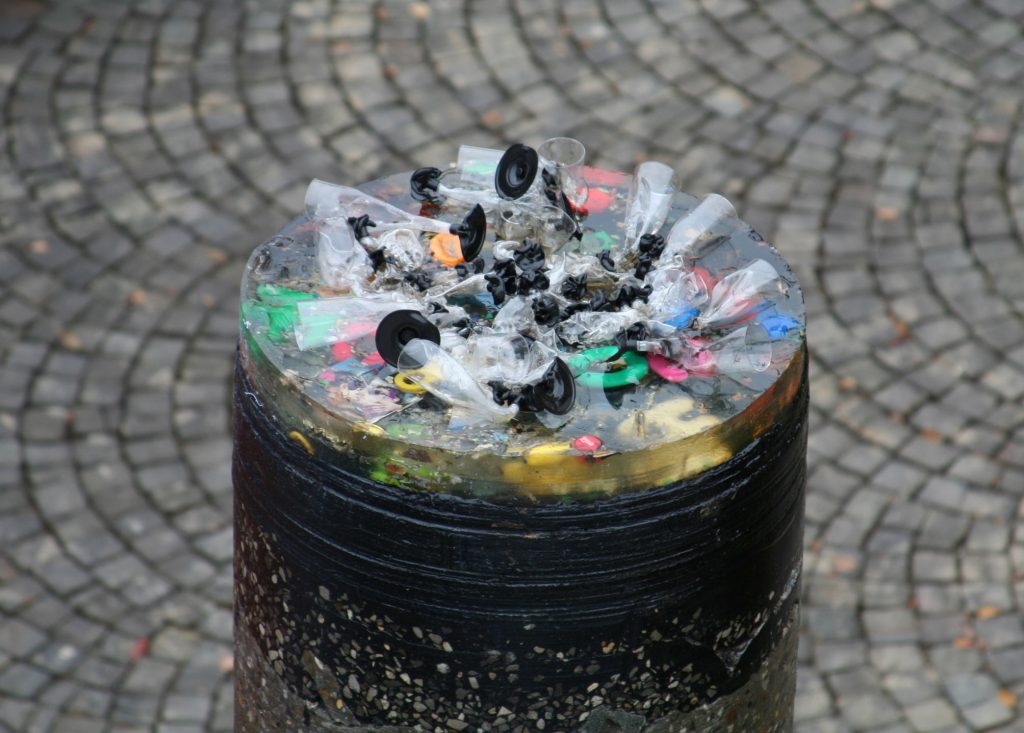
Mo(NU)mentum (detail), 2008. Various materials, 450 x 60 cm
The plastic fill of Mo(NU)mentum is a mere speck of the non-biodegradable trash found in the Great Pacific Garbage Patch, a swirling gyre of debris about the size of the continental United States, located approximately 1,000 miles west of California. Vanden Eynde’s Plastic Reef (2008–12), an expansive sculptural installation made from detritus collected during his travels to this and other gyres in the Pacific, Atlantic, and Indian Oceans, reflects what most fascinates him—the way in which all things come full circle. Consider a plastic bottle: derived in part from natural materials, it gets tossed into the water by a sunbather in California, is carried by currents past Japan, and then drifts to a gyre where the artist snares it in his net. He melts it and models it within a beautifully textured sculpted form, an amalgam of consumer garbage compressed as indistinguishable matter—as it is apt to wind up eons from now, when Anthropocene-age scree oozes back into the core of the earth as a synthetic mutation of nature.
In 2017, Vanden Eynde won the Public Prize of Belgian Art Prize for The Gadget (2017), a work that delves into the social histories swirling within this evolutionary whorl. It also represents his personal artistic development, for it is the outcome of residencies and travels throughout Africa and the United States for Triangle of Trade, a project that he began in 2015 to research the devastating consequences of Western civilization’s exploitation of human and natural resources in what is now the Democratic Republic of Congo. The Gadget—the nickname given to the Manhattan Project atomic test bomb that led to the 1945 bombings of Nagasaki and Hiroshima—visually knits together the histories of cotton and uranium as a link between Europe, the United States, and Africa.
The 19th-century U.S. cotton industry flourished on the backs of African slaves who harvested the crops shipped to Europe, especially Belgium, which was renowned for its magnificent lace. From 1908 to 1960, the Congo was a Belgian colony, where Africans mined the uranium used to produce the atomic bomb. Vanden Eynde conceived Gadget in collaboration with Rita Van Cotthem, a bobbin lace specialist. Detonating enormous visual and psychic energy, it consists of a lace atomic bomb suspended in a glass cylinder. Via wires projecting through the transparent container, the lace weapon connects to more than 300 wooden bobbins. The delicate, feminine form effectively explodes its phallic bobbins into space, ejecting bizarre and eerie messages about sexuality, power, creation, and global destruction.
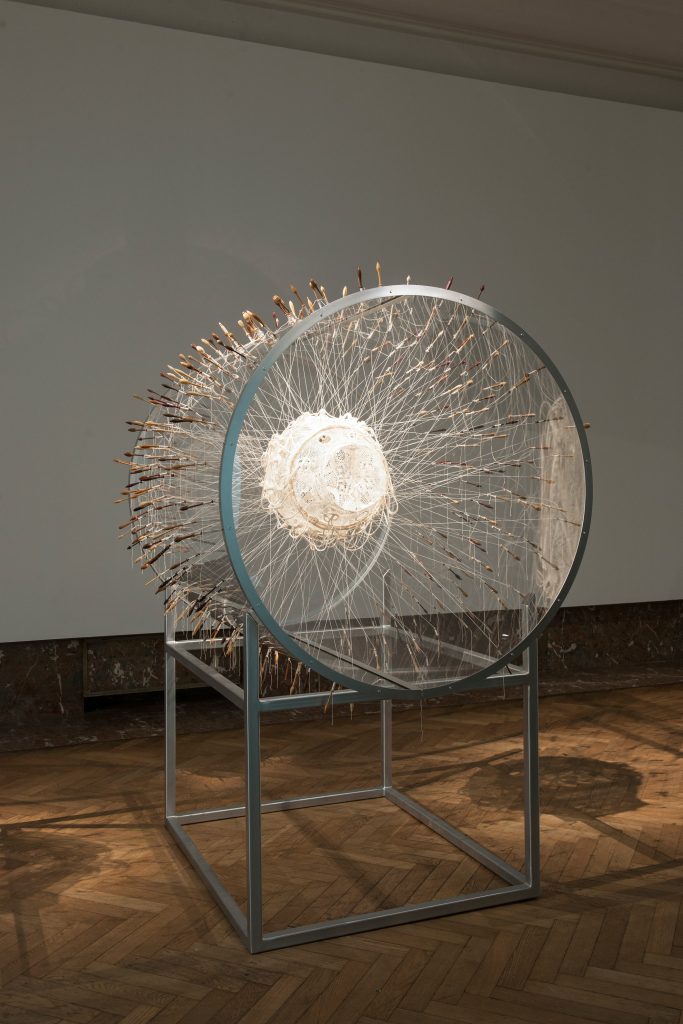
The Gadget, 2017. Cotton thread, wooden bobbins, acrylic glass cylinder, and aluminum frame, 140 x 150 x 200 cm (Photo: Philippe De Gobert)
War and weapons of mass destruction are one possible cause of extinction, and obsolescence is another, which Vanden Eynde studies in a broad range of works dealing with “technofossils”—discarded cell phones, circuit boards, and computers reduced to relics of the digital age that will likely find their way into the rocky Anthropocene crust. Technofossil (Samsung E570) (2015), a malachite cell phone carved into rock, provides one compelling example, while Cosmic Connection (2016) conveys technological obsolescence on a more monumental scale. Set in an open landscape beside a defunct 19th-century factory at the 2018 Riga Biennial, Vanden Eynde’s satellite dish filled with thousands of defunct circuit boards, stood mute, as impotent as the adjacent industrial complex.
Will humanity continue to evolve in this mute electronic landscape of the late or post-Anthropocene world? The Last Human (2017) presents a grim picture. It consists of a skeleton curled into a fetal position, embedded in a slab of concrete. Its skull, punctured with a smorgasbord of familiar computer parts, prophesizes the extinction of techno-humans as a consequence of humanity’s failed experiments with artificial intelligence. The Power of None (2018) gives a more positive spin to this dire scenario. Literally, figuratively—and brilliantly—the installation posits how the evolution of all things born of the earth and transformed by human technology ultimately sentences them to return to the earth’s core to be (re)sourced and reborn. For example, silicon, a natural material sifting through our toes as we walk on the beach, is found in over 90 percent of the earth’s crust. It is the basic material used to manufacture the microchips driving most of our semiconductor devices. The smaller these microchips are, the more that can be squeezed onto a single transistor to enable electronic equipment to run faster and more efficiently. But technology is getting ahead of the computer age as we know it: as the traditional silicon-based chip becomes too microscopic to function reliably, the end of the silicon age draws near.
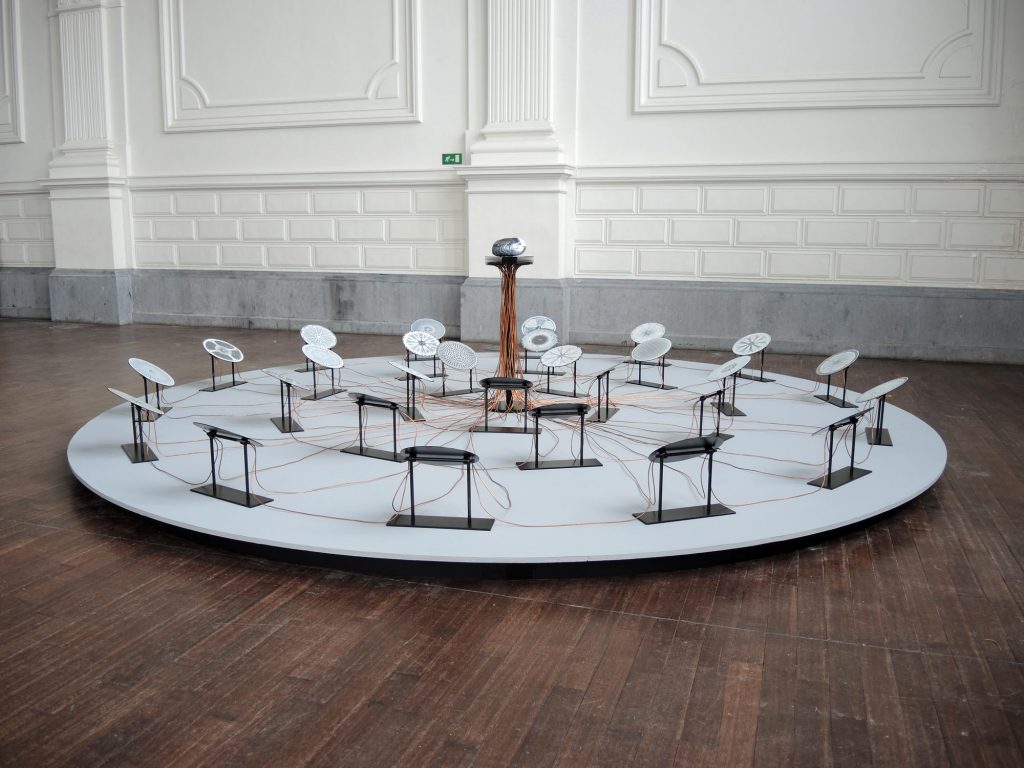
The Power of None, 2018. Wood, metal, copper wire, printed silicon wafers, and silicon-sculpted brain, 500 x 500 x 120 cm
The Power of None takes as its premise the theory that organically based cells made from single-celled algae can function as replacements for conventional microchips, delivering three times the energy of their outmoded predecessors. By placing a silicon computer in the shape of a human brain at the center of the installation, Vanden Eynde positions “brain-dead” human reasoning for recharging. The computer brain’s streaming copper wire arteries attach to a surrounding field of 28 silicon wafers placed on circular stands. Each wafer contains an enlarged print of a diatom—a micro-algae cell, itself enclosed in a natural wall of silicon. What might a future forensic archaeologist conclude on discovering the remains of such a resuscitated brain? What was the dynamic of the symbiotic relationship between humans and the natural world—did nature or humanity wield ultimate control? As Vanden Eynde poses these existential questions so does he welcome the dawn of a new age. For if, as Power of None suggests, technology will enable scientists to manufacture “wet” computer chips from organic matter, then it is possible that brain implants made with organic DNA will one day spark the intelligence of a new species programmed to strike a kinder, gentler relationship with planet Earth.